-
Cavaliero Finn has been an avid fan of Daniel’s work for a number of years. Apart from being an absolute joy to work with, Juliana and I have always loved the constant creative flow of Daniel’s work and find ourselves in awe of his many talents every time he produces a new series of works.

Daniel Reynolds: ‘Madrigal 2020’
Kinetic Sculpture in Hand Made Ceramic, Kiln Formed Glass, Gourd and Painted Steel.
Signed and Dated: Reynolds 2020, 2 m x 2.7 m , 24 kg weightLate last year, Cavaliero Finn was asked by The Crafts Council if Daniel would create a centrepiece mobile for its annual art fair, Collect, which took place just before the lockdown earlier this year. The piece (seen above) incorporated the largest elements Daniel has ever worked with to date, measuring 2m x 2.7m and weighing 24kg. It hung in the oval corridor in the West Wing of Somerset House in London during the art fair, reacting to the breeze and changing light of the space for which it was designed. It was nothing short of a masterpiece, plain and simple.
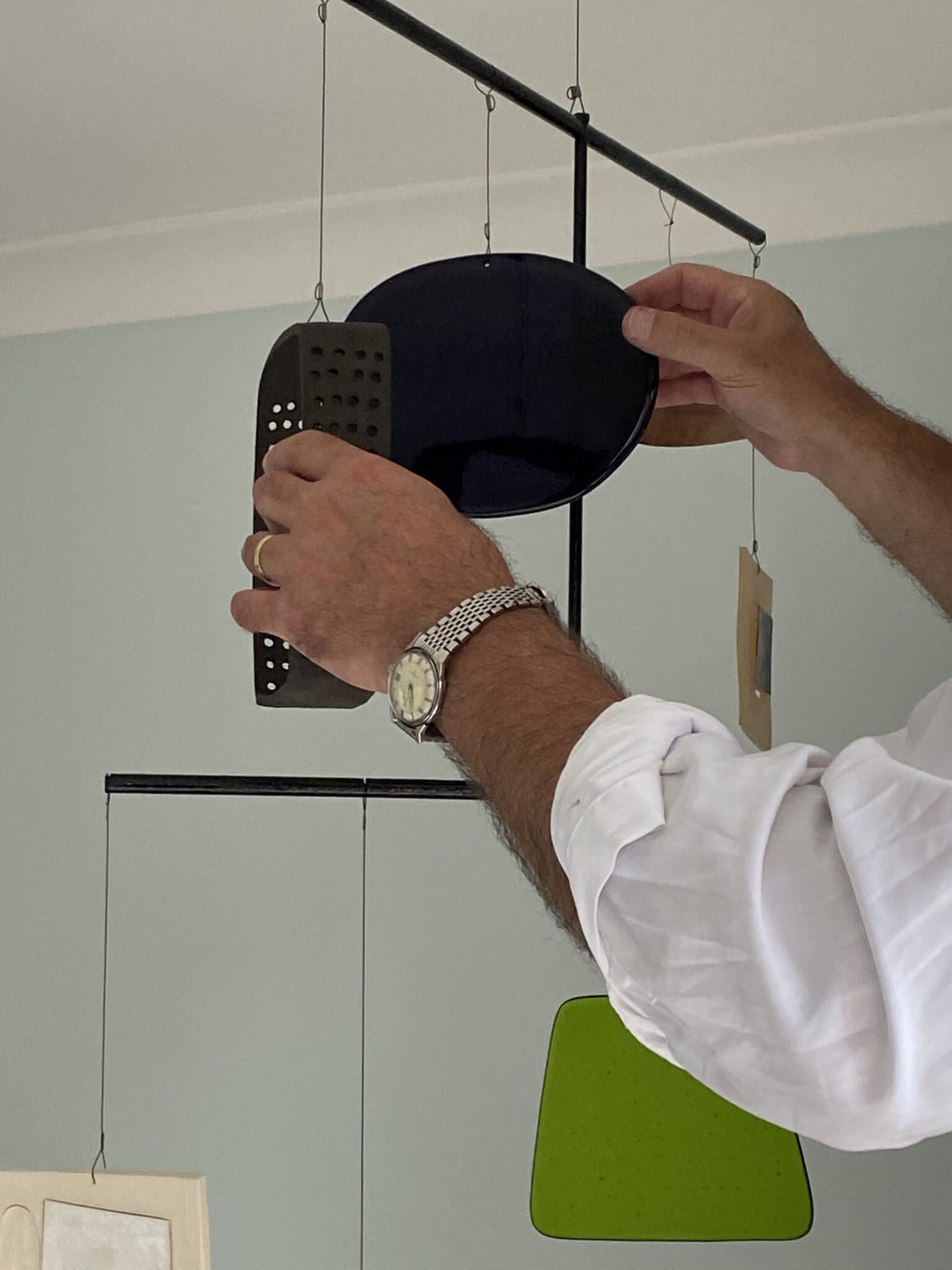
This week we had the pleasure of installing a somewhat smaller but just as impressive piece for a client who had seen his work at our stand at Collect. It was truly a magic moment to see the eight-piece, kinetic sculpture propelled by its own equilibrium in the client’s beautiful, light-filled room. It was almost as if the sculpture had been made for the space, like it had been there since the house was first built in the mid-sixties.
After the hard work was done, we caught up with Daniel for this week’s featured artist post, chatting to him about his work and inspirations.

Kinetic sculpture by Daniel installed in a client’s house this week
CF: You were born in Venezuela and lived there until you were nine, spending your formative years at school in Oxfordshire in the UK. Tell us a bit about your upbringing and the impact that this has had on your work Daniel.
DR: My parents were both interested in the arts, whether visual, music or literature and did their best to impart this interest to my siblings and me, growing up.
My father being from Chicago meant we spent some of our school holidays there from time to time. On these visits we were exposed to the breathtaking architecture and public art of this beautiful city.
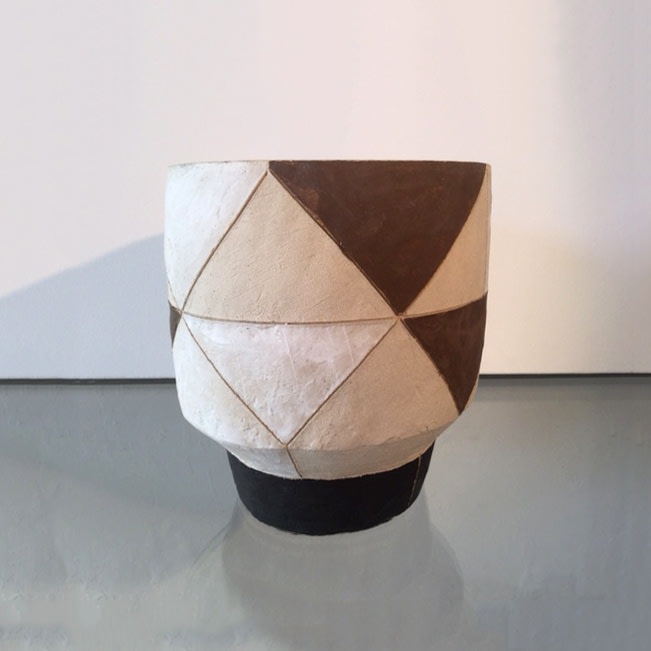
Daniel Reynolds: Geometric Chocolate Pot, Hand-built pot, 23 x 23.5 cm, 2020
DR: While in Caracas I remember our house being furnished mostly with good Scandinavian and North American contemporary design. I especially remember furniture by Arne Vodder and Harry Bertoia, Finish art glass and Danish ceramics. These pieces, along with modern abstract sculptures and paintings definitely helped to shape my own aesthetic preferences, albeit subconsciously at the time.
Caracas itself, during the 1950s and 1960s, experienced a golden age of building and art collecting as a city. Some of the West’s greatest artists and architects of the time were encouraged to come to take part in this building boom. Architects like Gio Ponti and Oscar Niemeyer, and artists such as Alexander Calder, Jean Arp, Fernand Leger and Victor Vasarely created exceptional works of art, mostly sculpture on a monumental scale, to complement the architecture being built.
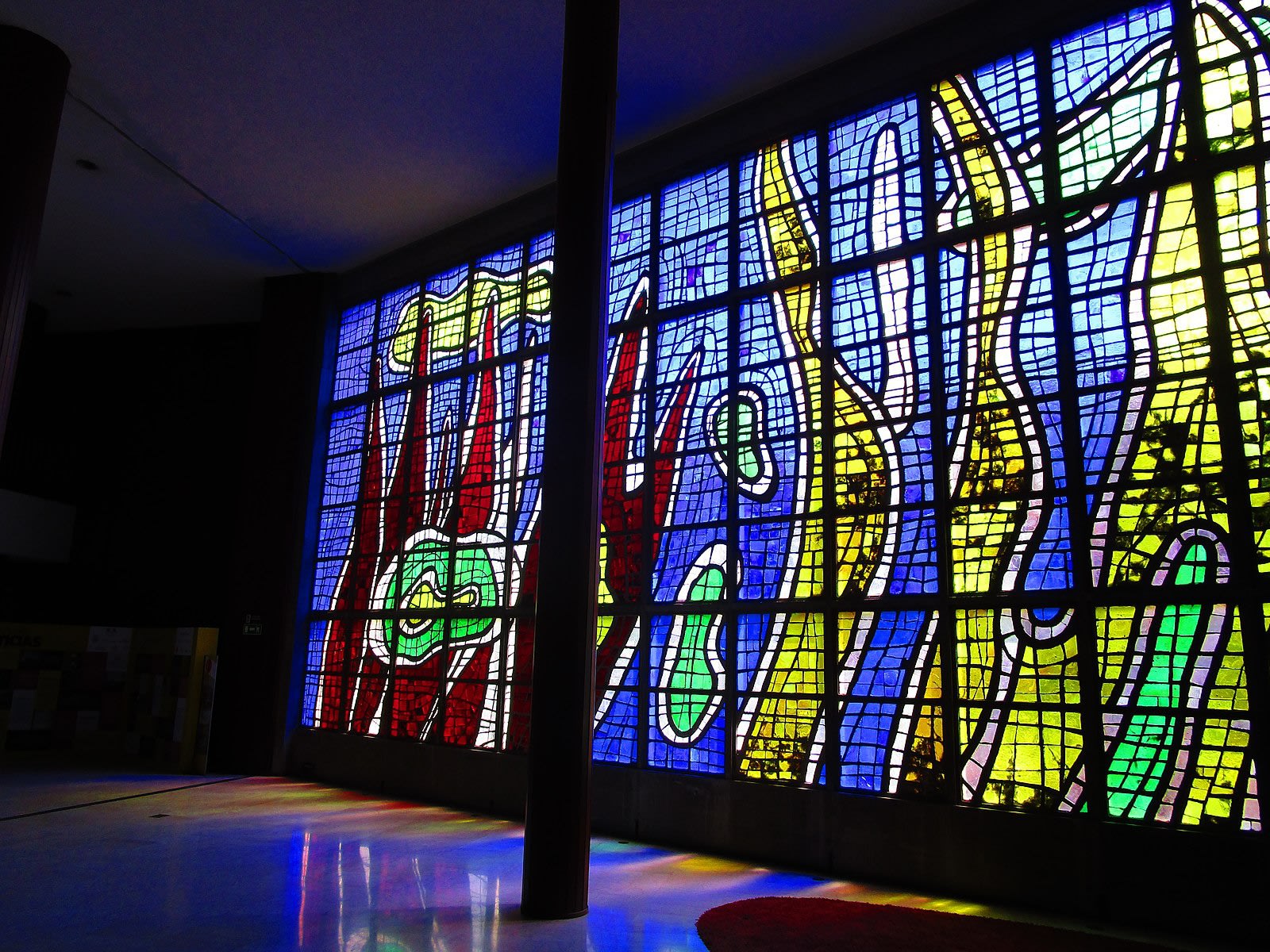
Stained glass windows for the University of Caracas by Fernand Leger (1954)

An example of Alexander Calder’s work “Calder Stories”, installation view at Centro Botin. Courtesy and copyright Calder Foundation, New York / VEGAP, Santander. Photography by Jessica Klingelfuss.
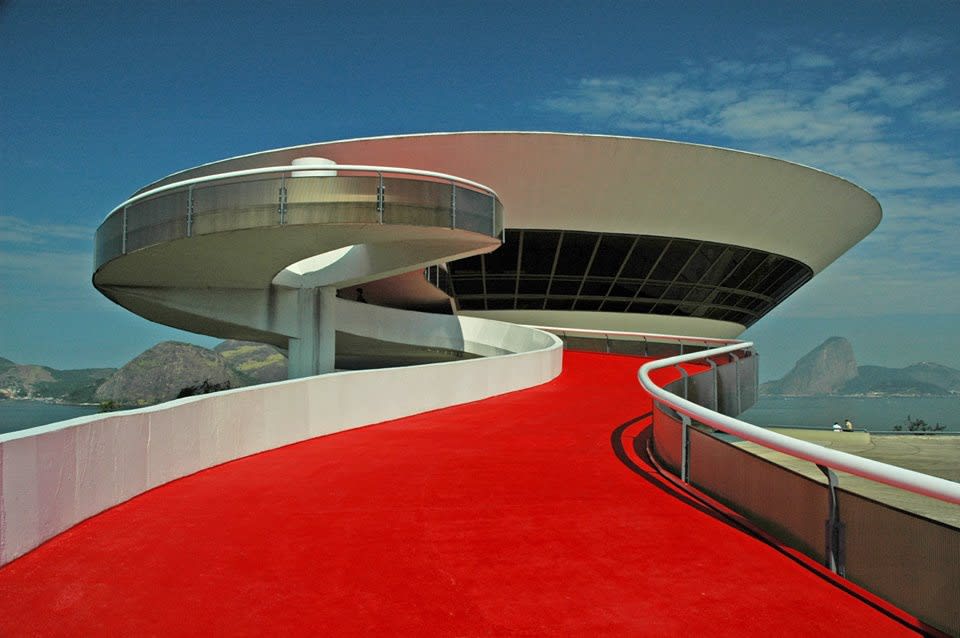
Oscar Niemeyer designed what would have been the Museum of Modern Art in Caracas between 1954 and 1955 but it was never realized. A later work, the Niterói Contemporary Art Museum in Rio de Janeiro, did come to fruition in 1996.
CF: You initially studied furniture design. How did you arrive at your current practice of working with ceramics? Has this study influenced your work in any way as an artist?
DR: Before studying furniture design at Middlesex, I studied sculpture and painting at Brighton Polytechnic. The thought that I may struggle after graduation, to create a client base for my abstract sculpture, led me at 19 to change courses in favour of a more ‘practical’ training in furniture design.I had some experience of working with clay while at Middlesex, where the eminent ceramic artist and potter Emmanuel Cooper was head of Ceramics at the time. He guided me through the process when I needed to make a couple of small tables in ceramic, as well as drawer handles and feet in matt porcelain for a small wooden cabinet I was designing.

Emmanuel Cooper – Porcelain bowl with a yellow glaze, metallic glazed rim and random gold spots.
Image courtesy of the Art Fund
DR: I continued to make furniture mostly in hard wood after graduating but never forgot how much I had enjoyed rediscovering ceramics under the tutelage of Emmanuel Cooper, after having done some basic pottery at prep school.
After graduating and ten years of building up a furniture studio producing ‘one-off’, quite sculptural pieces for residential use, I decided to dedicate my time to ceramics production while allowing myself to explore pure abstract sculpture for my own interest, never thinking I might exhibit it at any point. Clay as a material and its process felt more like what I wanted at the time. It seemed (and is) a more gentle way of making shapes and objects than to carve or machine saw them from wood.
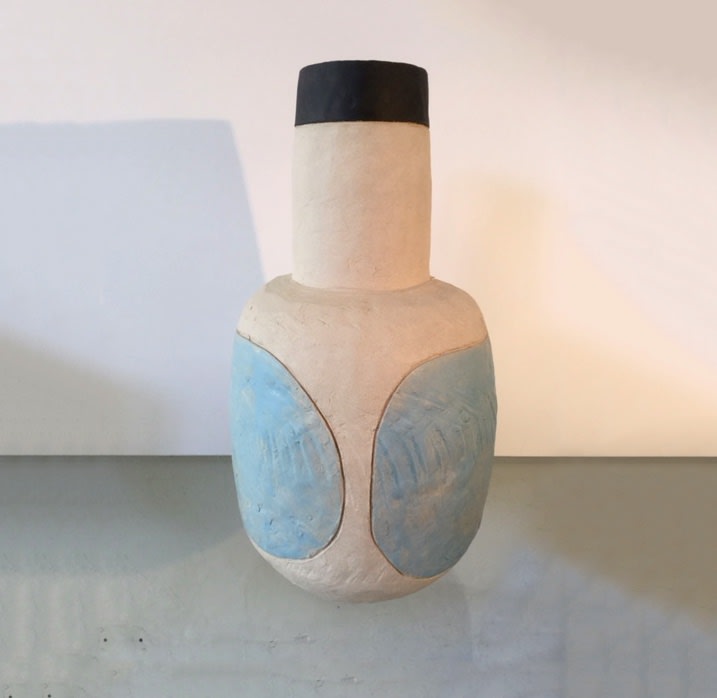
Daniel Reynolds, Pale Turquoise Wrap Around Vase, large hand-built pot, stoneware, 57 x 30 cm, 2020
CF: When did you make your first kinetic sculpture?
DR: I made my first piece of kinetic sculpture about twelve years ago. This was a small piece designed to sit on a table. It had a self supporting steel frame with various shapes in ceramic hanging down from the uppermost section. I really enjoyed making this piece and didn’t really want to sell it but someone fell in love with it and before I knew it was sold.
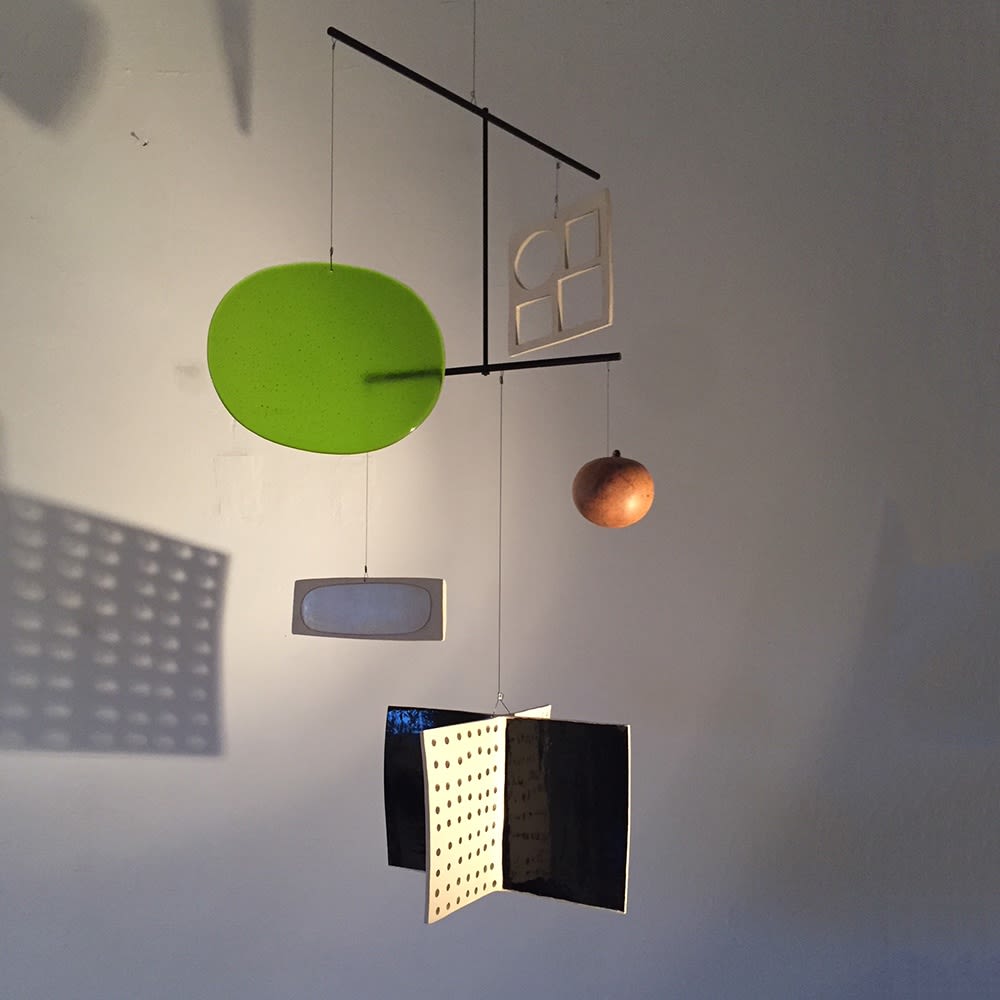
Daniel Reynolds, Yanomami Gourd Mobile, Hand Made Ceramic,
Kiln Formed Glass, Gourd and Painted Steel, 85 x 127 cm, 2020
The gourd used in this mobile was made by the Yanomami people in the Northern Amazon in VenezuelaCF: How do you go about planning and making your mobile sculptures?
DR: For the kinetic sculptures I like to make largely geometric elements in different materials which I lay out on a large table. I tend to make groups of certain shapes in varying sizes from which I will choose the right ones for a particular piece. The different elements almost choose themselves when I am assembling a new sculpture. This probably sounds strange, but what normally happens is that I give myself days to look at these pieces carefully and to evaluate the effect of each one when suspended individually. By the time I come to assemble a piece for a particular commission, I have a good idea of which pieces work well in unison.
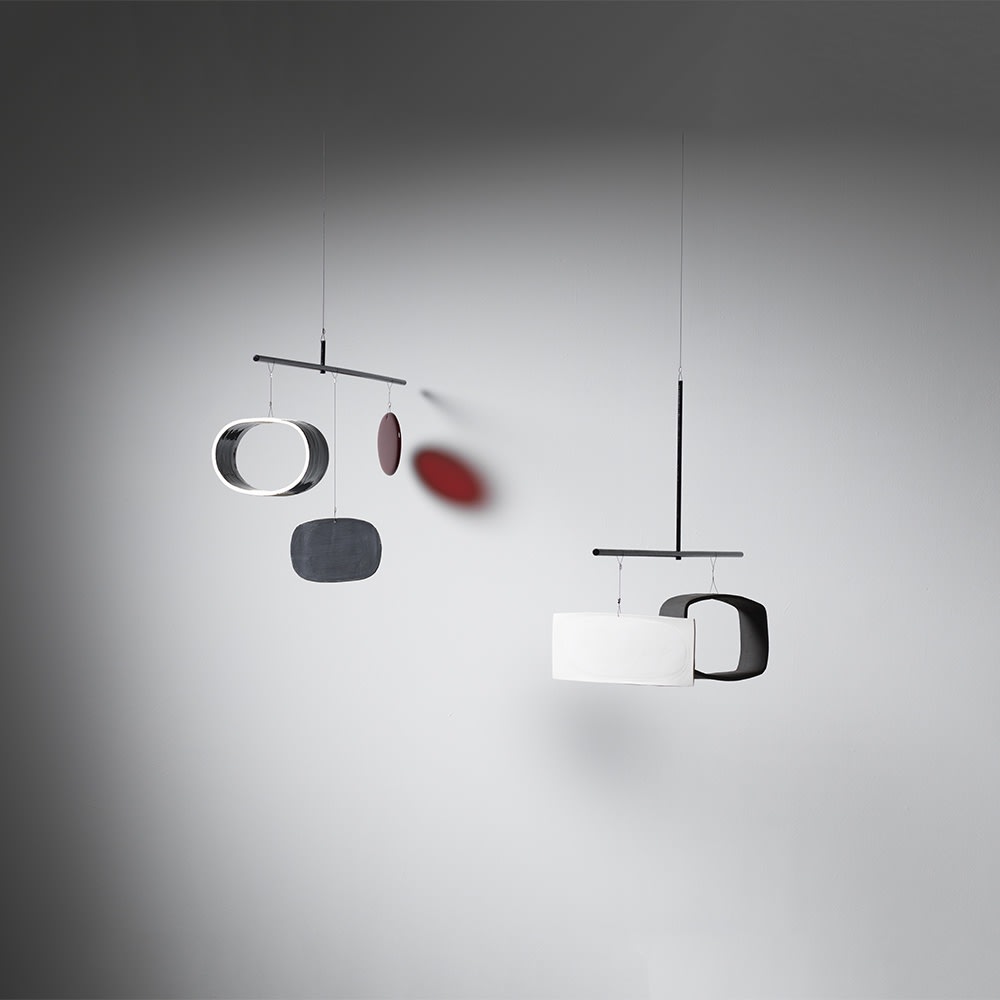
Daniel Reynolds: Double Axis Horizontal Kinetic Sculpture,
Stoneware, bone china, hand fused glass, W. 160 x L. 60 cms, 2019. Photo by Michael Harvey.
CF: How have you adapted your practice during the lockdown?
DR: During this period of lockdown I have worked mostly from our kitchen table in Kent, clearing it for supper every evening. Production has been a little interrupted for that reason, but I have recently started returning to my studio in Camberwell on average three or four times a week.
I have been able to find positive aspects to working this way; using the days at home for thinking, looking and planning as well as going for long (very) early morning walks along deserted beaches. This has brought to the experience of creating new sculptures an increased sense of contemplative joy which I have always tried to bring to my work.
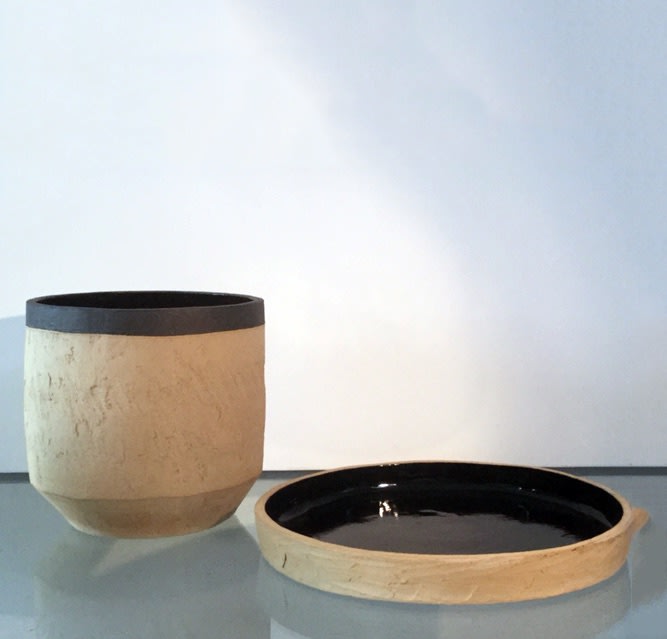
Daniel Reynolds: Sand and Obsidian Bucket Pot and Tray
Hand-built toasted stoneware tray, H 5 x Diam. 42 cm, 2020
Hand-built toasted stoneware pot, H 27.5 x Diam. 29 cm, 2020
CF: You are always exploring new methods to bringing your abstract designs to life. You work with porcelain, stoneware, and glass as well as organic materials such as gourds. Do you have a favourite material to work with and why?
DR: I appreciate the chance to make sculptural elements in ceramic but also like sometimes, where appropriate, to include pieces made from gourds, metal, wood and glass. These add visual interest and begin a kind of dialogue of materiality between the various elements.
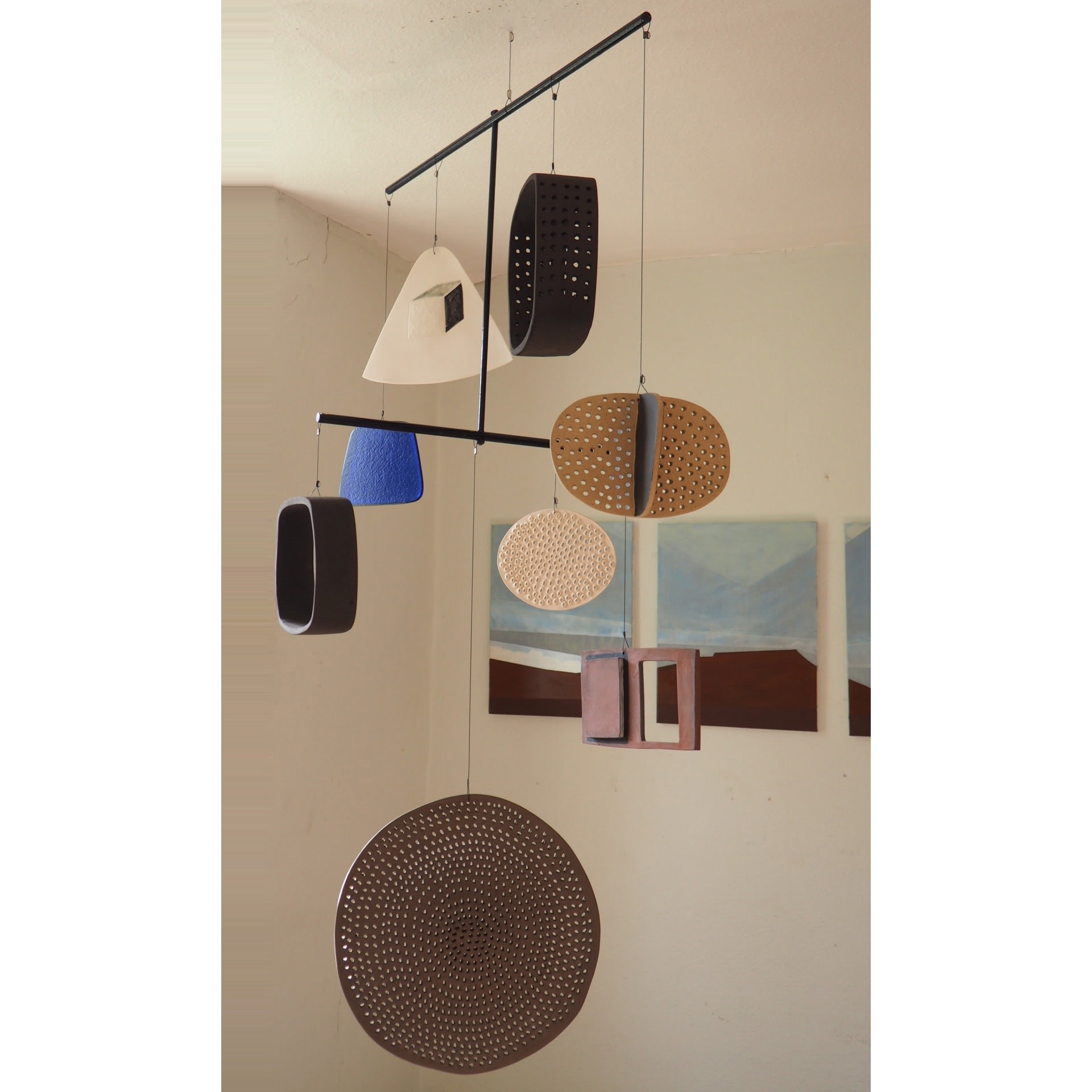
Daniel Reynolds: Eight-piece glass and ceramic kinetic sculpture,
around 90 cms across x 120 cms in length, weighing just under 4 kilos
CF: Which artists inspire you?
DR: It’s a very long list but the ones that come to mind initially are: Marcel Duchamp, Kenneth and Mary Martin, Robert Rauschenberg, Henry Moore, Jesus Rafael Soto, Elias Crespin, Ben Nicholson, Barbara Hepworth, Victor Pasmore, Alexander Calder, Jean Tinguely, William Scott, Patrick Heron, Adrian Heath, Ellsworth Kelly, Christian Vinck.

L’Onde du Midi by Elias Crespin – Public collection | Musée du Louvre, Paris

Photograph showing a hanging mobile by Kenneth Martin © Nigel Henderson Estate
CF: Do you have a favourite piece of art?
DR: The acoustic ceiling by Alexander Calder at the Aula Magna Concert Hall in Caracas, Venezuela of 1952.

he acoustic ceiling by Alexander Calder at the Aula Magna Concert Hall in Caracas, Venezuela
CF: Your work can often be site-specific. What is it that you like about working this way?
DR: I enjoy being able to react to a space and to create a work of art that takes into account the specific quality of the light, the way in which the space will be used, who by, and the areas that are adjacent to the particular space: be this a residential home or a public building. A dialogue with the client is essential to creating the right piece for a space.
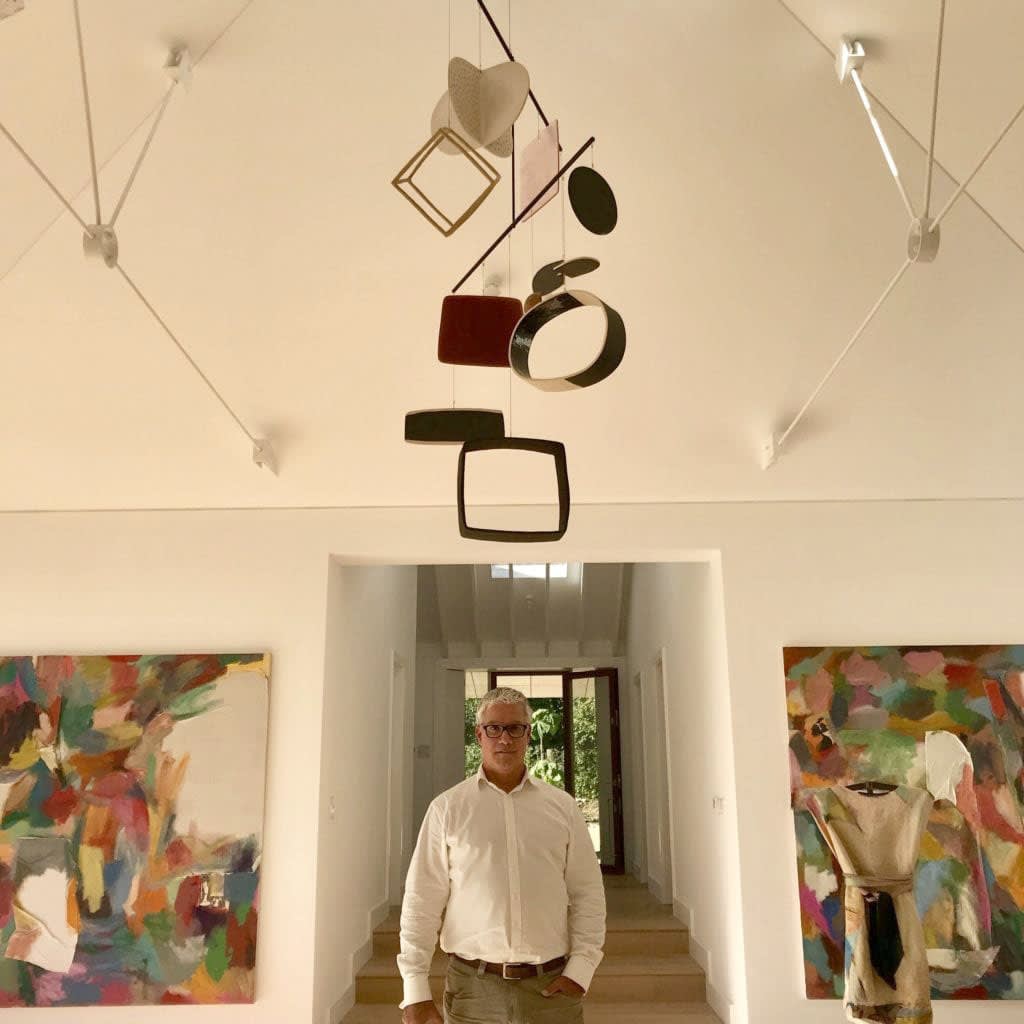
Daniel Reynolds at Design House, The New Art Centre, Wiltshire with his site-specific kinetic sculpture
Dreaming Dreams – ceramic, glass and painted steel, 3 meters x 2.5 meters, 2018
Artwork either side of Daniel is by Alexis Teplin.Please contact us if you would like to discuss commissioning a site-specific mobile sculpture for your home.
CF: You have recently moved into a new studio with more space, what will this open up for you in the future?
DR: Yes, the larger studio has allowed me to realise work on a scale I have been wanting to tackle for some time. The added space, including a large roof terrace, has meant that several projects can proceed simultaneously without the need to pack one thing away in order to make space on a table for another. It would be a dream realised to be commissioned to make work for a public space in the UK at some point. Watch this space, as they say!

Daniel hard at work in his new studio
